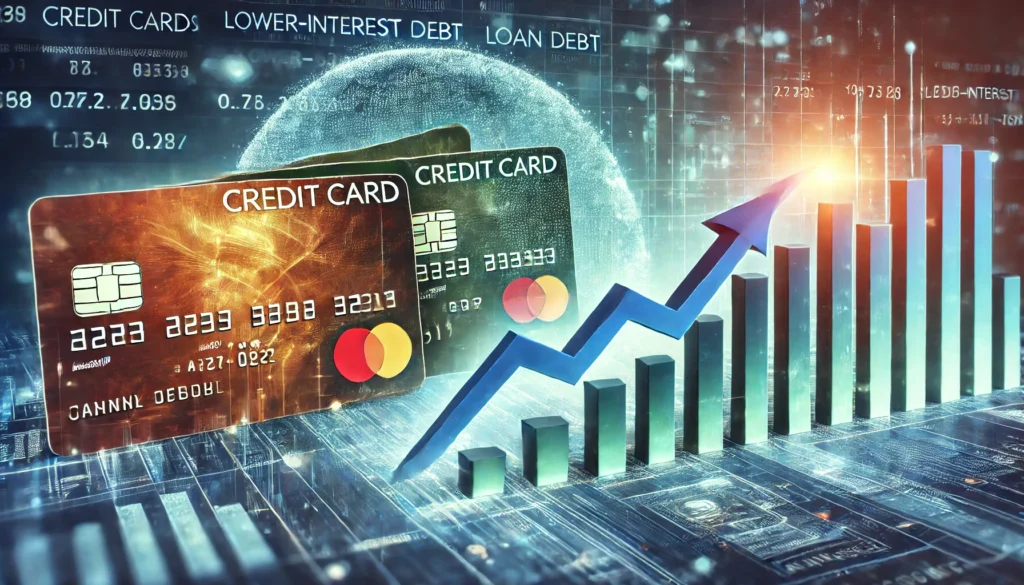Understanding the Importance of Refinancing Credit Card Debt
Credit card debt can become an overwhelming financial burden, especially when high-interest rates continue to accumulate over time. Many individuals find themselves stuck in a cycle of revolving balances, making it challenging to achieve financial freedom. One of the most effective strategies for breaking free from this cycle is to refinance credit card debt. By utilizing a credit card refinancing loan, borrowers can consolidate multiple high-interest debts into a single loan with more manageable payments and reduced interest rates. This approach not only simplifies debt repayment but also accelerates the process of becoming debt-free.
You may also like: Best Student Loan Refinance Options in 2025: Compare Rates & Save Thousands
When individuals refinance credit card debt, they effectively replace high-interest revolving credit with a lower fixed-rate loan. This shift allows borrowers to make predictable payments, which is particularly beneficial for those who struggle with fluctuating credit card interest rates. Furthermore, refinancing provides an opportunity to reorganize one’s financial landscape, improving overall cash flow management and reducing financial stress. Understanding how to leverage refinancing options wisely is key to ensuring long-term financial stability.

How Refinancing Lowers Interest Rates and Saves Money
One of the primary motivations for refinancing credit card debt is the potential for substantial interest savings. Credit cards typically come with high annual percentage rates (APRs), sometimes exceeding 20% or more. This level of interest accumulation makes it difficult to reduce principal balances, as a significant portion of each payment goes toward interest charges rather than the actual debt amount. By securing a credit card refinancing loan with a lower interest rate, borrowers can redirect more of their payments toward principal reduction.
A lower interest rate means that less money is spent servicing debt over time. For example, if an individual carries a $10,000 credit card balance with a 22% APR, the interest accrued over a year can be overwhelming. However, refinancing that debt into a personal loan with a 7% APR significantly reduces interest expenses, allowing the borrower to pay off the principal faster. Additionally, a structured repayment plan ensures that borrowers stay on track, minimizing the risk of prolonged debt accumulation.
Apart from the obvious financial savings, lower interest rates also contribute to improved credit scores. When high-interest debt is consolidated into a fixed-term loan, borrowers are less likely to miss payments or accumulate additional debt. Responsible debt management and timely payments can positively impact creditworthiness, making it easier to qualify for better financial products in the future.
Evaluating Different Credit Card Refinancing Loan Options
Choosing the right refinancing option is crucial for maximizing benefits and ensuring long-term financial success. Several types of credit card refinancing loan products exist, each with unique advantages and considerations. The most common refinancing options include personal loans, balance transfer credit cards, and home equity loans.
Personal loans are a popular choice for those looking to refinance credit card debt. These loans offer fixed interest rates, predictable monthly payments, and a structured repayment schedule. Many financial institutions provide competitive personal loan options, making it possible for borrowers to compare interest rates and loan terms. It is essential to evaluate factors such as loan fees, prepayment penalties, and the lender’s reputation before making a decision.
Balance transfer credit cards provide an alternative refinancing solution by allowing borrowers to transfer existing high-interest balances onto a new card with a 0% introductory APR. This approach can be highly beneficial if the borrower is confident in their ability to repay the transferred balance before the promotional period expires. However, balance transfer fees and post-promotional interest rates should be carefully reviewed to ensure that refinancing remains a cost-effective solution.
Home equity loans or home equity lines of credit (HELOCs) offer another refinancing avenue, particularly for homeowners with significant equity in their properties. These loans often come with lower interest rates than traditional credit cards or personal loans, making them an attractive option for debt consolidation. However, using home equity as collateral introduces additional risks, as failure to repay could result in foreclosure. Borrowers must weigh the benefits against the potential downsides before leveraging their home for debt refinancing.
Creating a Strategic Plan for Successful Refinancing
Successfully refinancing credit card debt requires careful planning and a clear repayment strategy. The first step in this process is assessing current financial standing and identifying the total amount of debt that needs refinancing. Understanding outstanding balances, interest rates, and monthly payments enables borrowers to make informed decisions about the best refinancing options available.
Once a suitable refinancing option has been selected, it is essential to develop a disciplined repayment plan. Refinancing should not be seen as an opportunity to accumulate more debt but rather as a strategic move toward financial freedom. Setting realistic monthly payment goals and avoiding unnecessary spending ensures that refinanced debt is repaid efficiently.
Another important consideration is maintaining a strong credit profile throughout the refinancing process. Consistently making on-time payments, keeping credit utilization low, and avoiding new debt accumulation are key factors in maintaining financial health. Responsible financial habits will not only help borrowers successfully pay off refinanced debt but also improve their overall creditworthiness.

Frequently Asked Questions (FAQ) on Credit Card Debt Refinancing
1. What are the key benefits of using a credit card refinancing loan? A credit card refinancing loan allows borrowers to consolidate multiple high-interest credit card balances into a single, more manageable payment. This often results in lower interest rates, making it easier to pay down debt faster while saving money on interest charges. Refinancing credit card debt can also improve cash flow, reducing financial stress and providing greater financial flexibility. Additionally, borrowers may see an improvement in their credit score by lowering their credit utilization ratio. Carefully selecting the right loan terms ensures long-term savings and improved financial stability.
2. How does refinancing credit card debt impact my credit score? Refinancing credit card debt can have both short-term and long-term effects on your credit score. Initially, applying for a credit card refinancing loan may result in a temporary dip due to a hard inquiry on your credit report. However, over time, successfully paying down debt with a lower-interest loan can improve your credit score. This is because reducing high-interest balances lowers credit utilization, one of the most significant factors in credit scoring. Additionally, making consistent payments on a refinancing loan builds a positive payment history, further boosting creditworthiness.
3. What should I consider when choosing a credit card refinancing loan? When selecting a credit card refinancing loan, consider the interest rate, loan term, and any associated fees. A lower interest rate is crucial in maximizing savings and accelerating debt repayment. It’s also important to assess the repayment period—shorter terms can lead to higher monthly payments but lower overall interest costs. Additionally, some lenders charge origination fees or prepayment penalties, which can impact the loan’s affordability. Comparing multiple lenders and reviewing their terms carefully ensures that you choose the best refinancing option for your needs.
4. Are there risks associated with refinancing credit card debt? While refinancing credit card debt can be a smart financial move, there are potential risks to consider. If the new loan has a longer repayment term, you may end up paying more in interest over time despite a lower rate. Some borrowers also face the temptation to continue using their credit cards after refinancing, leading to further debt accumulation. Additionally, missing payments on a credit card refinancing loan can negatively impact your credit score. To avoid these risks, it’s essential to establish a disciplined repayment plan and maintain responsible credit habits.
5. How do interest rates for credit card refinancing loans compare to credit card rates? Credit card refinancing loans typically offer significantly lower interest rates than credit cards, especially for borrowers with good to excellent credit. While average credit card interest rates can exceed 20%, refinancing loans may offer rates as low as 6-12%, depending on the borrower’s creditworthiness. Fixed interest rates on these loans provide stability, unlike credit card rates, which can fluctuate over time. By securing a lower interest rate, borrowers can reduce the total cost of their debt and pay it off faster. Comparing loan offers from various lenders ensures that you secure the best possible rate.
6. Can I refinance credit card debt multiple times? Yes, borrowers can refinance credit card debt multiple times, but it’s important to assess whether doing so is beneficial. Refinancing again may make sense if interest rates drop significantly or if your credit score has improved, allowing you to qualify for better terms. However, frequently applying for credit card refinancing loans can lead to multiple hard inquiries, temporarily lowering your credit score. Additionally, some lenders charge prepayment penalties or fees for refinancing an existing loan. Weighing the costs and benefits before refinancing again ensures that it aligns with your financial goals.
7. What’s the difference between a balance transfer and a credit card refinancing loan? A balance transfer involves moving credit card debt to another credit card, often with a 0% introductory APR for a limited period. In contrast, a credit card refinancing loan consolidates debt into a fixed-term personal loan with a predictable repayment schedule. While balance transfers can be useful for short-term savings, they often include transfer fees and require paying off the balance before the promotional period ends to avoid high-interest charges. Refinancing credit card debt with a loan provides more stability and structure for long-term debt management. Choosing between these options depends on financial discipline, credit limits, and repayment ability.
8. How do I qualify for a credit card refinancing loan? To qualify for a credit card refinancing loan, lenders typically require a good credit score, steady income, and a reasonable debt-to-income ratio. Borrowers with higher credit scores often receive lower interest rates and better loan terms. Providing proof of income and demonstrating a history of responsible credit usage can improve approval chances. Some lenders offer prequalification tools that allow borrowers to check their eligibility without impacting their credit score. Strengthening creditworthiness before applying can increase the likelihood of securing a favorable refinancing loan.
9. What strategies can help maximize savings when refinancing credit card debt? To maximize savings when refinancing credit card debt, start by securing the lowest possible interest rate and shortest feasible loan term. Avoid extending repayment periods unnecessarily, as longer terms may result in paying more interest overall. Once refinanced, refrain from accumulating new credit card debt to prevent future financial strain. Making extra payments when possible helps reduce the principal faster, saving on interest costs. Regularly monitoring credit health and maintaining on-time payments ensure long-term financial success.
10. Is refinancing credit card debt a good option for everyone? While refinancing credit card debt can be beneficial, it may not be suitable for all borrowers. Those with poor credit may struggle to secure a competitive interest rate, limiting the potential savings. Additionally, individuals who lack financial discipline may risk falling back into credit card debt after refinancing. Before proceeding, it’s essential to assess personal financial habits and ensure a stable repayment plan. For those committed to debt reduction, a credit card refinancing loan can be a powerful tool for achieving financial freedom.

Conclusion
Refinancing credit card debt is a powerful financial tool that offers significant benefits, including lower interest rates, simplified payments, and accelerated debt repayment. By selecting the right credit card refinancing loan and implementing a well-structured repayment plan, borrowers can take control of their finances and work toward long-term financial stability. However, successful refinancing requires careful planning, responsible debt management, and a commitment to avoiding future debt accumulation. With the right approach, refinancing credit card debt can be a transformative step toward financial freedom.
Tags: credit card debt solutions, debt refinancing strategies, financial planning for credit card debt, personal loan refinancing, balance transfer options, home equity loans for debt consolidation, responsible credit management, interest rate reduction, structured debt repayment, financial stability planning, improving credit scores, loan comparison tips, cash flow optimization, effective debt management, smart borrowing decisions, long-term financial health, credit utilization strategies, debt consolidation benefits, interest savings techniques, financial discipline for debt repayment
Further Reading:
Struggling with credit card debt? Here’s how to get out using smart repayment plans
How to Pay Off Credit Card Debt: 5 Strategies
These are the best ways to consolidate credit card debt
Legal Disclaimer
The information provided in this article is for general informational purposes only and is not intended to constitute financial, investment, legal, tax, or other professional advice. The content should not be relied upon for making any financial or investment decisions. Readers are encouraged to consult with licensed professionals, such as financial advisors, attorneys, or tax experts, to obtain personalized advice tailored to their individual circumstances. The author and publisher disclaim any liability for any actions taken or not taken based on the information provided in this article.





